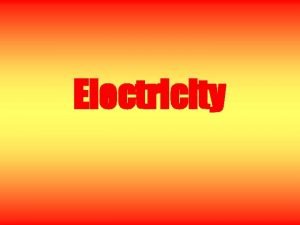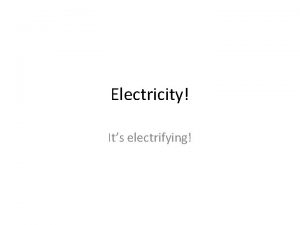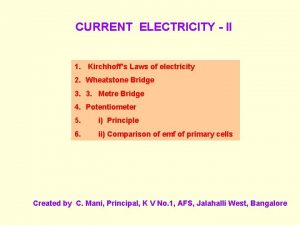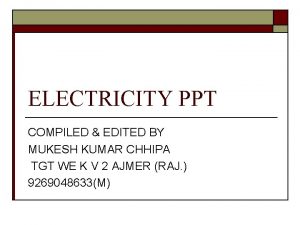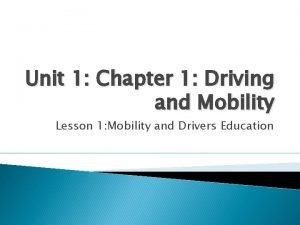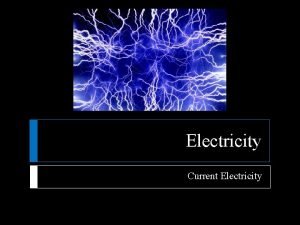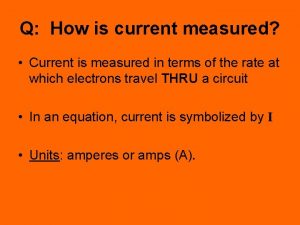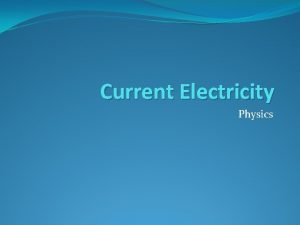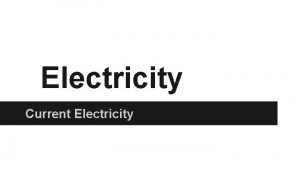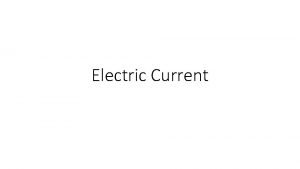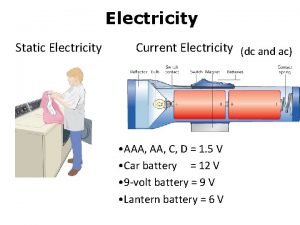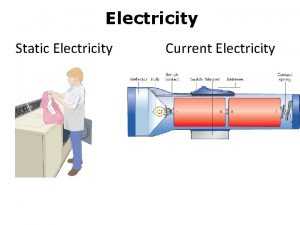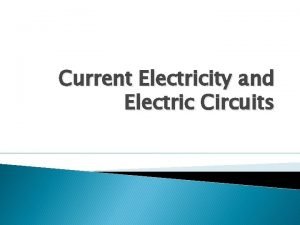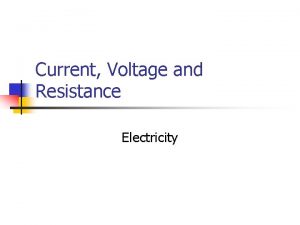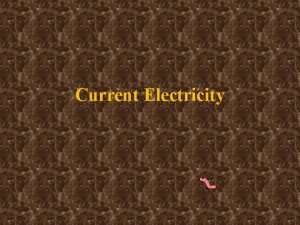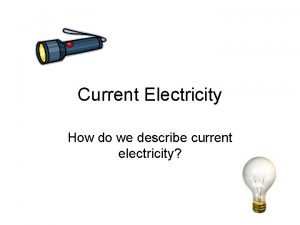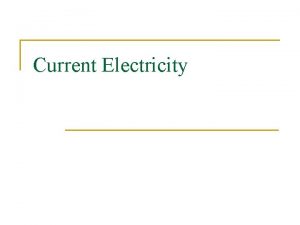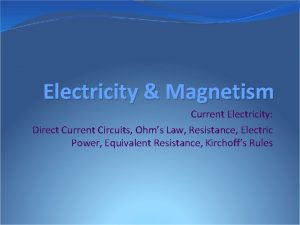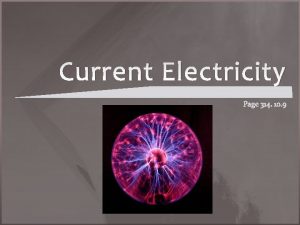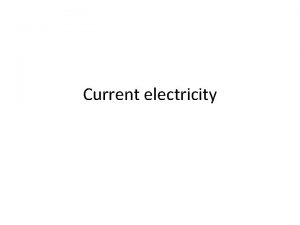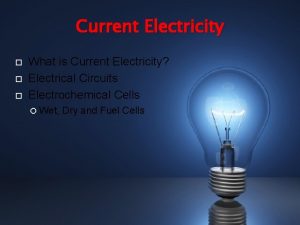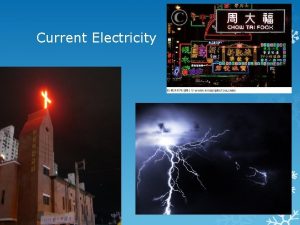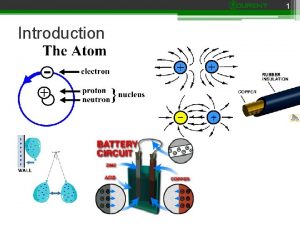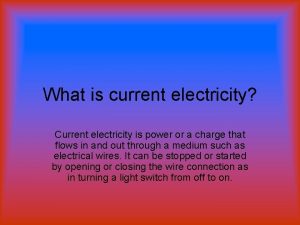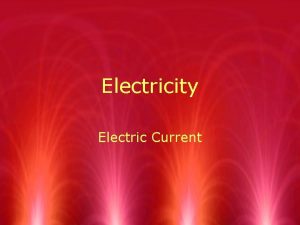Electricity Experiences and Outcomes Having measured the current













































































- Slides: 77

Electricity Experiences and Outcomes Having measured the current and voltage in series and parallel circuits, I can design a circuit to show the advantages and disadvantages of parallel circuits in an everyday application. SCN 3 -09 a I can help design simple chemical cells and use them to investigate the factors which affect the voltage produced. SCN 3 -10 a

Learning Intentions To explore what you know about electricity and find out something new about electricity To understand how we generate some of our electricity To understand the dangers of electricity

Lesson Starter In the back of your class jotter: • Write down all the times you have used electricity since waking up this morning.

What We Know Already • In your group: • Discuss what you already know and understand about electricity. For example, what facts, words and meanings do you know about electricity? • Write a summary of what you and your group have talked about in your jotter. You might use a mind map, bullet points or a table. • Share your summary with the rest of the class when everyone is ready.

In your jotter: • Write the heading “What We Know Already about Electricity” • Write three key points about electricity https: //www. twigonglow. com/film/what-iselectricity-1540/

What is Electricity? • Electricity is a type of energy and we rely on it everyday. • Generating electricity is expensive and we are trying to find cheaper and renewable ways of generating electricity. • http: //www. educationscotland. gov. uk/weatherand climatechange/energy/renewable/hydroelectric. asp

Renewable Energy • Scotland currently generates 41. 6% of our electricity from renewable sources. • The Scottish Government wants to make this 100% by 2020! • In Iceland, 87% of their electricity comes from hydroelectricity! • 100% of Iceland's space heating and water heating is obtained from geothermal sources!

Electrical Safety • Electrical faults are one of the most common causes of fires in the home. • You should check your smoke alarms once every week and change the batteries once every year. • https: //www. twigonglow. com/film/electricalsafety-1542/

Success Criteria ü I found out something new about electricity ü I understand how we generate some of our electricity ü I understand the dangers of electricity

Lesson Starter 1. Name three appliances that use electricity. 2. Why do grown ups keep telling you to turn lights off when you’ve stopped using them. 3. How often should you check your smoke alarms? 4. What country is a world leader in renewable energy?

Conductors and insulators Learning intention • To understand the difference between conductors and insulators. • To be able to build circuits.

Conductors and insulators • Today, we will test a number of materials to see if they are conductors or insulators • What you will need: – Circuit board, 2 batteries, 1 bulb, 3 wires – 1 bag of insulators and conductors • Build a circuit that lights the bulb.

Conductors and insulators - + Test Material • Test each material • The bulb will light up if a current flows • Note the conductors and insulators in a table

Results Material Conductor Insulator Copper strip Steel strip Aluminium strip Rubber tubing Plastic strip Glass slide Graphite pencil Remember: It’s a conductor if the bulb lights, if not it’s an insulator!

Results Material Conductor Insulator Copper strip yes no Steel strip yes no Aluminium strip yes no Rubber tubing no yes Plastic strip no yes Glass slide no yes Graphite pencil yes no

Conclusion A conductor allows electricity to pass through it. Examples: copper, iron, aluminium. An insulator does not allow electricity to pass through it. Example: rubber, glass, perspex.

Summary • A material which allows electricity to pass through it is a conductor • A material which does not allow electricity to pass through it is an insulator • All metals are conductors such as the copper wire inside an electric cable • Most non-metals are insulators such as the plastic cover on an electrical cable • Insulators are important because they prevent us from getting electrical shocks

Success Criteria ü I can build working circuits. ü I know the difference between conductors and insulators.

Lesson Starter • 1. What is a conductor? • 2. Give an example of a material that is a conductor. • 3. What is an insulator? • 4. Give an example of a material that is an insulator.

Learning intention To be able to draw six different circuit symbols To be able to draw a circuit diagram

Circuit symbols Draw this table in your jotters Name of Symbol component Cell Name of Symbol component Switch Wire Voltmeter Bulb/lamp Ammeter

Rules for circuit diagrams • Always use a ruler. • Use circuit symbols only. • Circuit symbols are never drawn at the corners of circuit diagrams.

Circuit diagrams • Using two batteries and one bulb build a circuit that lights the bulb. • Draw the circuit diagram. • Using three batteries and two bulbs build a circuit that lights the bulb. • Draw the circuit diagram.

Circuit diagrams

Circuit diagrams • Using two batteries, one bulb and a switch build a circuit where the switch turns the bulb on and off. • Draw the circuit diagram. • Using three batteries, two bulb and a switch build a circuit where the switch turns the bulbs on and off. • Draw the circuit diagram.

Circuit diagrams

Success Criteria ü Can draw the circuit symbols for 6 electrical components. ü I can successfully draw a circuit diagram

Lesson Starter • Draw three circuit symbols. • Draw a circuit diagram with two batteries, a bulb and a switch, where the switch turns the bulb on and off.

Learning Intentions To understand the definition of current. To understand the defintion of voltage To be able to draw and identify series circuits.

Current • Current is the flow of electrons (negative charges) or electricity round a circuit. • It is measured using an ammeter. • Current has the symbol I • It is measured in units called amperes or A

Voltage • Voltage is the energy given to each electron in a circuit. • We measure voltage using a voltmeter. • Voltage has the symbol V and it has units measured in volts or V.

Types of circuits • A circuit is an electrical path around which charge or electricity can flow (current). • There are two types of circuits: – Series – Parallel

Series Circuit • In a series circuit there is only one electrical path and all the components are connected in a chain or in a row. • A series circuit looks like this:

Series Circuit Summary • Two bulbs connected in series: – If you disconnect one bulb the other bulb goes out. • • • As you add more batteries the bulbs get brighter. As you add more bulbs, the bulbs get dimmer. When one bulb is disconnected, the other bulbs go off. There is no other route for the electricity. The charges (current) flows through every component.

Series Circuit • Build a series circuit with one battery and one bulb and draw in your jotter. • Add more batteries • Write down what happens. • Begin with one battery and one bulb again. • Add more bulbs • Write down what happens • Disconnect one of the bulbs. • Write down what happens.

Success Criteria ü I understand the definition of current. ü I understand the definition of voltage ü I can draw and identify series circuits.

Lesson Starter • Draw a series circuit with one battery and two bulbs.

Learning Intention To be able to draw and identify a parallel circuit.

Parallel Circuit • Build a circuit with one battery and one bulb. • What do you notice about the brightness of the bulb(s) when you add more bulbs in parallel? • What do you notice when you disconnect one of the bulbs?

Parallel Circuit • In a parallel circuit there is more than one electrical path. • The different paths for the electricity are known as branches.

Parallel Circuit • Two bulbs connected in parallel: – If you disconnect one bulb the other bulb stays lit. • Bulbs connected in parallel have the same brightness. • As you add more bulbs in parallel the brightness of each bulb does not change by much.

Parallel Circuit • Build a parallel circuit with one battery and one bulb. • What do you notice when you add more batteries? • What do you notice when you add more bulbs in parallel? • What do you notice when you disconnect one of the bulbs?

Parallel Circuit • Why do you think parallel circuits are useful in the home?

Success Criteria ü I can draw and identify a parallel circuit.

Electricity Experiences and Outcomes Having measured the current and voltage in series and parallel circuits, I can design a circuit to show the advantages and disadvantages of parallel circuits in an everyday application. SCN 3 -09 a

Lesson Starter • Explain the difference between a series and parallel circuit.

Learning Intentions To be able to draw series and parallel circuits using correct symbols.

Homework Complete homeworks 1 & 2 (homeworks are online) Due Wednesday 28 th October.

Circuit Diagrams - Exercise 1 1. Draw a series circuit with one battery and one bulb. 2. Draw a series circuit with two batteries, one bulb and a switch. 3. Draw a series circuit with three batteries, two bulbs and a switch.

Circuit Diagrams - Exercise 2 • Draw a parallel circuit with one battery and two bulbs (one bulb per branch) • Draw a parallel circuit with two batteries and three bulbs (2 bulbs on one branch and one bulb on the other) • Draw a parallel circuit with three batteries, three bulbs (one bulb in each branch) and switches that allow each bulb to be turned on and off separately.

Lesson Starter • Draw a parallel circuit with one battery, three bulbs (one bulb in each branch) and switches that allow each bulb to be turned on and off separately.

Learning Intentions To be able to add ammeters into a circuit and understand how to read them. To understand the circuit rules for current in series and parallel.

Ammeters are used to measured current. Current is measured in amperes. We always put ammeters in series with our bulbs. Ammeters have the circuit symbol: A - +

Ammeters Build the circuit opposite. Draw the circuit diagram for this circuit. Write your reading for the current next to your ammeter. Remember the units for current! - +

Ammeters Draw this as a circuit diagram! It should look like A - +

Ammeter Now put the ammeter on the other side of the bulb and note the reading. A - +

Ammeter • An ammeter is a device used for measuring electrical current in a circuit. • An ammeter is always connected in series with other electrical components. • An ammeter is always placed • beside the other • component - +

Current in a series circuit A 3 A 1 A 2 • Build a series circuit with 2 bulbs and 3 cells. • Draw the circuit diagram. • Add in the ammeter at the 3 places shown and note the readings on your diagram. • What did you find?

Current in a series circuit • The current at each point was the same! The rule for this is: A 1 = A 2 = A 3 A 1 A 2 Current of battery = current 1 = current 2 … OR Isupply = I 1 = I 2 …

Current in a parallel circuit Now we build a circuit with two batteries and two bulbs in parallel.

Ammeters A 4 A 1 A 2 A 3 • Draw the circuit diagram and then add your ammeter to the places shown. • Write your readings on your diagram. • What did you find?

Current in parallel rule A 4 A 1 A 2 A 3 • The current was different at each point in the circuit. • The rule for this is: Current of battery = current 1 + current 2 … OR Isupply = I 1 + I 2 …

Success Criteria ü I know how to add ammeters into a circuit and understand how to read them. ü I know and understand the circuit rules for current in series and parallel.

Starter 1. Draw the symbol for an ammeter 2. Explain how an ammeter is connected to a circuit?

Learning Intentions To understand what voltage is To be able to measure voltage correctly using a voltmeter

What is voltage? • Voltage is the term used to describe electrical energy. • Voltage is the quantity of energy that each charge has in a battery or circuit. • The units of voltage is volts (V).

Voltmeters • Voltmeters have the circuit symbol: • Voltmeters are always connected in parallel or across electrical components. • Voltmeters measure voltage (V). V

Voltage in Series 1. Build a series circuit with one bulb and 2 cells. 2. Add a voltmeter. 3. Write down the voltage across the bulb. - + V V Remember! Voltmeters always go in parallel. - +

Voltage in Series • Detach the voltmeter from your series circuit. • Add another bulb and cell to your circuit. • Measure the voltage across both bulbs and then across the cells. V V V Draw the circuit diagram and write your voltages beside each bulb. What did you find?

Voltage in Series • The voltage of the • The rule for this is: bulbs were • Voltage of cells = different, but they voltage 1 + voltage added up to the 2 +… voltage of the cells! Or Vsupply=V 1 + V 2 …

Voltage in Parallel • Now we’re going to • Place a voltmeter find out the rule for across the cells to voltage in parallel. measure the supply voltage. • Build a circuit with • Use the voltmeter to then measure two cells and two the voltage of each bulbs in parallel. bulb.

Vs V 1 V 2 Voltage in Parallel • Draw the circuit diagram and write your voltages next to your cells and bulbs. • What did you find?

Voltmeter • The voltage across the bulbs was the same as the voltage of the cells. Voltage of cells = voltage 1 = voltage 2 … OR Vsupply = V 1 = V 2…

Success Criteria ü I know that the voltage is the amount of energy given to each charge in a circuit. ü I can use a voltmeter to measure voltage in series and in parallel.

Lesson Starter 1. Draw a parallel circuit with three batteries, two bulbs and one switch (that can be used to control both lights at one time)

Current and Voltage Current: Series – Parallel – Voltage: Series – Parallel -

Nerves of Steel • As a class we want to investigate who has the steadiest hands. • You will be given some apparatus and you will have to come up with an experiment which will prove this!
 Static electricity and current electricity
Static electricity and current electricity Static electricity and current electricity
Static electricity and current electricity Magnetism vocabulary
Magnetism vocabulary Current is measured in
Current is measured in Electrons flowing
Electrons flowing What is electrical
What is electrical Electricity def
Electricity def Bill nye series and parallel circuits
Bill nye series and parallel circuits Current electricity
Current electricity What is current electricity in physics
What is current electricity in physics Current electricity ppt
Current electricity ppt Venn diagram series and parallel circuits
Venn diagram series and parallel circuits Y connected generator
Y connected generator Difference between phase voltage and line voltage
Difference between phase voltage and line voltage Semiconductor
Semiconductor Ac systems lesson 4
Ac systems lesson 4 Drift current and diffusion current
Drift current and diffusion current What is diffusion current and drift current
What is diffusion current and drift current Line current and phase current
Line current and phase current Holding current and latching current
Holding current and latching current Diffusion current density
Diffusion current density The value of vgs that makes is approximately zero
The value of vgs that makes is approximately zero All of the heat produced by sma weld stays in the weld.
All of the heat produced by sma weld stays in the weld. Hazard based safety engineering
Hazard based safety engineering Kcl mesh analysis
Kcl mesh analysis Film the boy in the striped pyjamas
Film the boy in the striped pyjamas Lines of latitude run from
Lines of latitude run from How are latitude and longitude measured
How are latitude and longitude measured When multiplying and dividing measured quantities
When multiplying and dividing measured quantities Crash costs are measured in dollars and in
Crash costs are measured in dollars and in Hát kết hợp bộ gõ cơ thể
Hát kết hợp bộ gõ cơ thể Ng-html
Ng-html Bổ thể
Bổ thể Tỉ lệ cơ thể trẻ em
Tỉ lệ cơ thể trẻ em Gấu đi như thế nào
Gấu đi như thế nào Tư thế worms-breton
Tư thế worms-breton Bài hát chúa yêu trần thế alleluia
Bài hát chúa yêu trần thế alleluia Môn thể thao bắt đầu bằng chữ f
Môn thể thao bắt đầu bằng chữ f Thế nào là hệ số cao nhất
Thế nào là hệ số cao nhất Các châu lục và đại dương trên thế giới
Các châu lục và đại dương trên thế giới Công thức tính độ biến thiên đông lượng
Công thức tính độ biến thiên đông lượng Trời xanh đây là của chúng ta thể thơ
Trời xanh đây là của chúng ta thể thơ Mật thư tọa độ 5x5
Mật thư tọa độ 5x5 Phép trừ bù
Phép trừ bù Phản ứng thế ankan
Phản ứng thế ankan Các châu lục và đại dương trên thế giới
Các châu lục và đại dương trên thế giới Thể thơ truyền thống
Thể thơ truyền thống Quá trình desamine hóa có thể tạo ra
Quá trình desamine hóa có thể tạo ra Một số thể thơ truyền thống
Một số thể thơ truyền thống Cái miệng nó xinh thế chỉ nói điều hay thôi
Cái miệng nó xinh thế chỉ nói điều hay thôi Vẽ hình chiếu vuông góc của vật thể sau
Vẽ hình chiếu vuông góc của vật thể sau Biện pháp chống mỏi cơ
Biện pháp chống mỏi cơ đặc điểm cơ thể của người tối cổ
đặc điểm cơ thể của người tối cổ Thứ tự các dấu thăng giáng ở hóa biểu
Thứ tự các dấu thăng giáng ở hóa biểu Vẽ hình chiếu đứng bằng cạnh của vật thể
Vẽ hình chiếu đứng bằng cạnh của vật thể Vẽ hình chiếu vuông góc của vật thể sau
Vẽ hình chiếu vuông góc của vật thể sau Thẻ vin
Thẻ vin đại từ thay thế
đại từ thay thế điện thế nghỉ
điện thế nghỉ Tư thế ngồi viết
Tư thế ngồi viết Diễn thế sinh thái là
Diễn thế sinh thái là Các loại đột biến cấu trúc nhiễm sắc thể
Các loại đột biến cấu trúc nhiễm sắc thể Các số nguyên tố
Các số nguyên tố Tư thế ngồi viết
Tư thế ngồi viết Lời thề hippocrates
Lời thề hippocrates Thiếu nhi thế giới liên hoan
Thiếu nhi thế giới liên hoan ưu thế lai là gì
ưu thế lai là gì Hươu thường đẻ mỗi lứa mấy con
Hươu thường đẻ mỗi lứa mấy con Sự nuôi và dạy con của hươu
Sự nuôi và dạy con của hươu Hệ hô hấp
Hệ hô hấp Từ ngữ thể hiện lòng nhân hậu
Từ ngữ thể hiện lòng nhân hậu Thế nào là mạng điện lắp đặt kiểu nổi
Thế nào là mạng điện lắp đặt kiểu nổi Third step of nursing process
Third step of nursing process Example of learning objectives
Example of learning objectives Collaborative interventions nursing
Collaborative interventions nursing Reported speech objectives
Reported speech objectives Monitor is input or output device
Monitor is input or output device Examples of ifsp outcomes and strategies
Examples of ifsp outcomes and strategies





